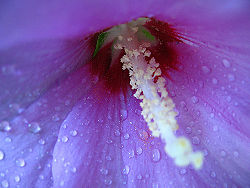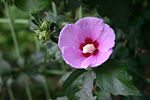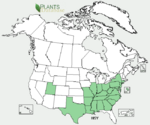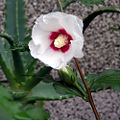Rose of Sharon
| Rose of Sharon |
|---|

|
| Scientific Classification |
|
| Binomial Name |
|
Hibiscus syriacus |
Hibiscus syriacus is a species of dicot flowering plants best know for being the National flower of the Republic of Korea. It is commonly referred to as the Rose of Sharon, although it is doubtful the species is actually the plant referred to in the Bible.
Anatomy
Hibiscus syriacus grows 6 to 10 feet tall and 4 to 10 feet wide. Usually the root is located underneath the surface ground. On the stem, there are several 2 to 4 inches shiny dark green leaves. It is simple deciduous type with an alternate arrangement. It has ovate and rhomboid shape. The leaves are green in all seasons. [2] It also has three long lobes and from there it blooms one or two flowers. It might be 3 inches large with different colors including white, pink, purple, and blues which are based on the crimson color. Its species names depend on color, leaf variegation and size.[3] It fructifies irregular shape of brown fruit. It is about to 0.5 to 1 inch big. It is dry or hard. [4]
Ecology
Hibiscus syriacus is distributed in Asia including China, Northern India, Japan, Korea and also in Middle East, Europe and North America where it was found before 1600. [5]
For about 100 days from early July to late October it is flower season and each day it blooms. During that time, a single plant can produce about 2000 to 3000 flowers. Because it blooms a lot of flowers it has strong rate of survival and also when it is transplanted to other area or cut off it can recover easily. Because of that it represents long and healthy life in Korea.[6]
It needs little pruning to develop stronger but it unnecessary until the plant grows slowly and become a tight upright form. The best time to prune in late winter or early spring. Frequent pruning gives plant bigger flowers but fewer. No pruning gives many smaller flowers. [7]
What it mean to Korea
National Flower of Republic of Korea
Hibiscus syriacus (called the Rose of Sharon) is a national flower of the Republic of Korea. From the Korean history book, it says that Korean believe it as a heavenly flower since ancient time. Also during ancient time, there was a Kingdom called Silla in Korea and it called itself Mugunghwa Country. Mugunghwa is a Korean name for Rose of Sharon. And even from a Chinese book referred Korea as "The land of gentleman where Mugunghwa bloomed". In 19th century, there was a national anthem base on Mugunghwa which is named Mugunghwa Samcheolli Hwaryeo Gangsan which means that land is thousand mile of beautiful mountains and rivers which cover with Mugunghwa. Because Mugunghwa was such an important part in Korean culture, after Korea became free from the Japan Korean government put it as a national flower. [8]
Meaning and Cultural Representation
Mugunghwa is very strength and fertility which reflect to Korean history. Because Korea is in between two strong countries China and Japan, we had very hard time. They attack from both sides. When Korea was once rule over by Japan but from these suffering and anguish we stand up fought back. This Korean history is very similar to the life of the Rose of Sharon. So people choose as a national flower which can embody our history.
The name, Hibiscus, comes from beautiful Egyptian goddess Hibis. Sharon, is the most blessed land in Canaan with full of honey and milk. So it can be called beautiful flower which it grows in blessed land of Sharon.
Hibiscus syriacus produces a lot of flowers which represent the grandeur and joy. It means a lot not only to Korea but also other countries.[9]
Human Use
The shrub can be used in many different ways. People in Korea used bark to make paper and used it as a medicine too. The dried bark used to get better from the fever and also could make it to antidote that can heal other internal disease. According to the Korean herbal medicine book, Dongeuibogam, it also can make to brew which can stop bleeding and reduce thirst when you drink it. Also people use young leaves to make side dishes and tea bags. [10]
Gallery
References
- History&Chractersitics of Mugunghwa ROSA (Rose of Sharon Association)
- Hibiscus syriacus USDA (United States Department of Agriculture)
- Hibiscus syriacus Rose-of-Sharon Edward F. Gilman and Dennis G. Watson, US Department of Agriculture
- Hibiscus syriacus Floridata








